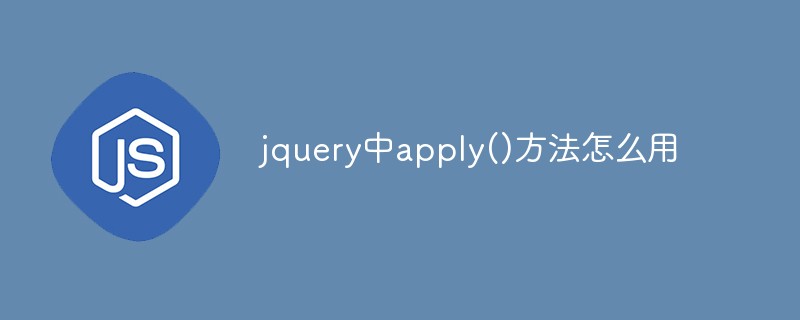Without further ado, let’s get straight to the point. Let’s first look at some simple methods. These methods are all methods that encapsulate jQuery.ajax() for our convenience. Of course, if you want to handle complex logic, you still need to Using jQuery.ajax() (this will be discussed later).
1. load( url, [data], [callback] ): Load the remote HTML file code and insert it into the DOM.
url (String): The URL address of the requested HTML page.
data (Map): (optional parameter) key/value data sent to the server.
callback (Callback): (optional parameter) The callback function when the request is completed ( does not need to be success's ).
This method uses the GET method by default. If the [data] parameter has data passed in, it will be automatically converted to the POST method. In jQuery 1.2, you can specify a selector to filter the loaded HTML document, and only the filtered HTML code will be inserted into the DOM. The syntax is "url #some > selector".
This method can easily dynamically load some HTML files, such as forms.
Sample code:
$(".ajax. load").load("http://www.php100.com/index.html .post",
function (responseText, textStatus, XMLHttpRequest){
this;//Here this points to the current DOM object, that is, $(".ajax.load")[0]
//alert(responseText);//The content returned by the request
//alert(textStatus);//Request status: success, error
//alert(XMLHttpRequest);//XMLHttpRequest object
});
2. jQuery.get( url, [data], [callback] ): Use GET method to make asynchronous requests
Parameters:
url (String): URL address to send the request.
data (Map): (Optional) Data to be sent to the server, Expressed in the form of Key/value pairs, it will be appended to the request URL as QueryString.
callback (Function): (optional) Callback function when loading is successful (this method is called only when the return status of Response is success).
This is a simple GET request function to replace the complex $.ajax. The callback function can be called when the request is successful. If you need to execute a function on error, use $.ajax. Sample code:
$.get("./Ajax.aspx", {Action:"get",Name:"lulu"}, function (data, textStatus){
//returned data It can be xmlDoc, jsonObj, html, text, etc.
this; // Here this points to the option configuration information of the Ajax request, please refer to the figure below
alert(data);
//alert(textStatus);//Request status: success, error, etc.
Of course, error cannot be captured here, because the callback function will not be run at all when there is an error.
//alert(this);
});
Click to send the request:
This in the jQuery.get() callback function points to the option configuration information of the Ajax request:

Parameters:
url (String): URL address to send the request.
data (Map): ( Optional) The data to be sent to the server, expressed in the form of Key/value pairs.
callback (Function): (optional) Callback function when loading is successful (this method is called only when the return status of Response is success).
type (String): (optional) The official description is: Type of data to be sent. It should actually be the type of client request (JSON, XML, etc.)
This is a simple POST request function to replace the complex $.ajax. The callback function can be called when the request is successful. If you need to execute a function on error, use $.ajax. Sample code:
Ajax.aspx:
Response. ContentType = "application/json";
Response.Write("{result: '" Request["Name"] ",Hello! (This message comes from the server)'}");
jQuery code:
$.post("Ajax. aspx", { Action: "post", Name: "lulu" },
function (data, textStatus){
// data can be xmlDoc, jsonObj, html, text, etc.
/ /this; // For the option configuration information of this Ajax request, please refer to this mentioned in jQuery.get()
alert(data.result);
}, "json");
Click to submit:
The request format is set to "json" here:

If you set the request format to "json" and you do not set the ContentType returned by Response to: Response.ContentType = "application/json"; then you will not be able to capture it. to the returned data.
Note that alert(data.result); since the Accept header is set to "json", the data returned here is an object, and there is no need to use eval() to convert it into an object.
4. jQuery.getScript( url, [callback] ): Request to load and execute a JavaScript file through GET method.
Parameters
url (String): The address of the JS file to be loaded.
callback (Function): (optional) callback function after successful loading.
Before jQuery 1.2, getScript could only call JS files in the same domain. In 1.2, you can call JavaScript files across domains. Note: Safari 2 or earlier cannot execute scripts synchronously in the global scope. If you add a script via getScript, please add a delay function.
This method can be used, for example, to load the JS files required by the editor when only the editor is focus(). Here are some sample codes:
Load and execute test.js.
jQuery code:
$.getScript("test.js");
Load and execute AjaxEvent.js, and display information after success.
jQuery code:
$.getScript("AjaxEvent.js", function(){
alert("AjaxEvent.js is loaded and executed. Can you click the Get or Post button above to see the difference? ");
});
After loading, please click the Load request above again to see the difference.
jQuery Ajax Events
Ajax requests generate several different events that we can subscribe to and process our logic in them. There are two types of Ajax events in jQuery: local events and global events.
Local events are defined within the method during each Ajax request, for example:
$.ajax({
beforeSend: function(){
// Handle the beforeSend event
},
complete: function(){
// Handle the complete event
}
// ...
});
The global event is triggered by every Ajax request, and it will All elements in the DOM are broadcast, and the script loaded in the getScript() example above is the global Ajax event. Global events can be defined as follows:
$("#loading" ).bind("ajaxSend", function(){
$(this).show();
}).bind("ajaxComplete", function(){
$(this).hide( ; >
$("#loading").ajaxStart(function(){
});
The code is as follows:
$.ajax({
global: false,// Disable global Ajax events.
// ...
下面是jQuery官方给出的完整的Ajax事件列表:
ajaxStart (Global Event)
This event is broadcast if an Ajax request is started and no other Ajax requests are currently running.
•beforeSend (Local Event)
This event, which is triggered before an Ajax request is started, allows you to modify the XMLHttpRequest object (setting additional headers, if need be.)
•ajaxSend (Global Event)
This global event is also triggered before the request is run.
•success (Local Event)
This event is only called if the request was successful (no errors from the server, no errors with the data).
•ajaxSuccess (Global Event)
This event is also only called if the request was successful.
•error (Local Event)
This event is only called if an error occurred with the request (you can never have both an error and a success callback with a request).
•ajaxError (Global Event)
This global event behaves the same as the local error event.
•complete (Local Event)
This event is called regardless of if the request was successful, or not. You will always receive a complete callback, even for synchronous requests.
•ajaxComplete (Global Event)
This event behaves the same as the complete event and will be triggered every time an Ajax request finishes.
ajaxStop (Global Event)
This global event is triggered if there are no more Ajax requests being processed.
具体的全局事件请参考API文档。
好了,下面开始说jQuery里面功能最强的Ajax请求方法 $.ajax();
jQuery.ajax( options ) : 通过 HTTP 请求加载远程数据
这个是jQuery 的底层 AJAX 实现。简单易用的高层实现见 $.get, $.post 等。
$.ajax() 返回其创建的 XMLHttpRequest 对象。大多数情况下你无需直接操作该对象,但特殊情况下可用于手动终止请求。
注意: 如果你指定了 dataType 选项,请确保服务器返回正确的 MIME 信息,(如 xml 返回 "text/xml")。错误的 MIME 类型可能导致不可预知的错误。见 Specifying the Data Type for AJAX Requests 。
当设置 datatype 类型为 'script' 的时候,所有的远程(不在同一个域中)POST请求都回转换为GET方式。
$.ajax() 只有一个参数:参数 key/value 对象,包含各配置及回调函数信息。详细参数选项见下。
jQuery 1.2 中,您可以跨域加载 JSON 数据,使用时需将数据类型设置为 JSONP。使用 JSONP 形式调用函数时,如 "myurl?callback=?" jQuery 将自动替换 ? 为正确的函数名,以执行回调函数。数据类型设置为 "jsonp" 时,jQuery 将自动调用回调函数。(这个我不是很懂)
参数列表:
| 参数名 | 类型 | 描述 |
| url | String | (默认: 当前页地址) 发送请求的地址。 |
| type | String | (默认: "GET") 请求方式 ("POST" 或 "GET"), 默认为 "GET"。注意:其它 HTTP 请求方法,如 PUT 和 DELETE 也可以使用,但仅部分浏览器支持。 |
| timeout | Number | 设置请求超时时间(毫秒)。此设置将覆盖全局设置。 |
| async | Boolean | (默认: true) 默认设置下,所有请求均为异步请求。如果需要发送同步请求,请将此选项设置为 false。注意,同步请求将锁住浏览器,用户其它操作必须等待请求完成才可以执行。 |
| beforeSend | Function | 发送请求前可修改 XMLHttpRequest 对象的函数,如添加自定义 HTTP 头。XMLHttpRequest 对象是唯一的参数。<span style="COLOR: #0000ff">function</span> (XMLHttpRequest) {<br>
<span style="COLOR: #0000ff">this</span>; <span style="COLOR: #008000">// the options for this ajax request</span>
}
|
| cache | Boolean | (默认: true) jQuery 1.2 新功能,设置为 false 将不会从浏览器缓存中加载请求信息。 |
| complete | Function | 请求完成后回调函数 (请求成功或失败时均调用)。参数: XMLHttpRequest 对象,成功信息字符串。<span style="COLOR: #0000ff">function</span> (XMLHttpRequest, textStatus) {<br>
<span style="COLOR: #0000ff">this</span>; <span style="COLOR: #008000">// the options for this ajax request</span>
}
|
| contentType | String | (默认: "application/x-www-form-urlencoded") 发送信息至服务器时内容编码类型。默认值适合大多数应用场合。 |
| data | Object, String |
发送到服务器的数据。将自动转换为请求字符串格式。GET 请求中将附加在 URL 后。查看 processData 选项说明以禁止此自动转换。必须为 Key/Value 格式。如果为数组,jQuery 将自动为不同值对应同一个名称。如 {foo:["bar1", "bar2"]} 转换为 '&foo=bar1&foo=bar2'。 |
| dataType | String |
预期服务器返回的数据类型。如果不指定,jQuery 将自动根据 HTTP 包 MIME 信息返回 responseXML 或 responseText,并作为回调函数参数传递,可用值: "xml": 返回 XML 文档,可用 jQuery 处理。 "html": 返回纯文本 HTML 信息;包含 script 元素。 "script": 返回纯文本 JavaScript 代码。不会自动缓存结果。 "json": 返回 JSON 数据 。 "jsonp": JSONP 格式。使用 JSONP 形式调用函数时,如 "myurl?callback=?" jQuery 将自动替换 ? 为正确的函数名,以执行回调函数。 |
| error | Function | (默认: 自动判断 (xml 或 html)) 请求失败时将调用此方法。这个方法有三个参数:XMLHttpRequest 对象,错误信息,(可能)捕获的错误对象。<span style="COLOR: #0000ff">function</span> (XMLHttpRequest, textStatus, errorThrown) {<br>
<span style="COLOR: #008000">// 通常情况下textStatus和errorThown只有其中一个有值 </span>
<span style="COLOR: #0000ff">this</span>; <span style="COLOR: #008000">// the options for this ajax request</span>
}
|
| global | Boolean | (默认: true) 是否触发全局 AJAX 事件。设置为 false 将不会触发全局 AJAX 事件,如 ajaxStart 或 ajaxStop 。可用于控制不同的Ajax事件 |
| ifModified | Boolean | (默认: false) 仅在服务器数据改变时获取新数据。使用 HTTP 包 Last-Modified 头信息判断。 |
| processData | Boolean | (默认: true) 默认情况下,发送的数据将被转换为对象(技术上讲并非字符串) 以配合默认内容类型 "application/x-www-form-urlencoded"。如果要发送 DOM 树信息或其它不希望转换的信息,请设置为 false。 |
| success | Function | 请求成功后回调函数。这个方法有两个参数:服务器返回数据,返回状态<span style="COLOR: #0000ff">function</span> (data, textStatus) {<br>
<span style="COLOR: #008000">// data could be xmlDoc, jsonObj, html, text, etc...</span>
<span style="COLOR: #0000ff">this</span>; <span style="COLOR: #008000">// the options for this ajax request</span>
}
|
There are several Ajax event parameters here: beforeSend, success, complete, error. We can define these events to handle each of our Ajax requests well. Note that this in these Ajax events all points to the option information of the Ajax request (please refer to the picture of this when talking about the get() method).
Please read the above parameter list carefully. If you want to use jQuery for Ajax development, you must be familiar with these parameters.
Sample code to get the article title on the blog homepage:
$.ajax({
type: "get",
url: "http://www.cnblogs.com/rss",
beforeSend: function(XMLHttpRequest){
//ShowLoading();
},
success: function(data, textStatus){
$(".ajax.ajaxResult").html("");
$("item ",data).each(function(i, domEle){
$(".ajax.ajaxResult").append("
});
},
complete: function(XMLHttpRequest, textStatus){
//HideLoading();
},
error : function(){
//Request error handling
}
});
A list of homepage articles will be displayed here.
Others
jQuery.ajaxSetup( options ): Set global AJAX default options.
Set the default address of AJAX requests to "/xmlhttp/", disable triggering of global AJAX events, and use POST instead of the default GET method. Subsequent AJAX requests will not set any option parameters.
jQuery code:
$.ajaxSetup ({
url: "/xmlhttp/",
global: false,
type: "POST"
});
$.ajax({ data: myData });
serialize() and serializeArray()
serialize(): The content of the sequence table table is a string.
serializeArray(): Serialize table elements (similar to '.serialize()' method) and return JSON data structure data.
Example:
HTML code:
Results:

serializeArray() The result is:

 jquery实现多少秒后隐藏图片Apr 20, 2022 pm 05:33 PM
jquery实现多少秒后隐藏图片Apr 20, 2022 pm 05:33 PM实现方法:1、用“$("img").delay(毫秒数).fadeOut()”语句,delay()设置延迟秒数;2、用“setTimeout(function(){ $("img").hide(); },毫秒值);”语句,通过定时器来延迟。
 jquery怎么在body中增加元素Apr 22, 2022 am 11:13 AM
jquery怎么在body中增加元素Apr 22, 2022 am 11:13 AM增加元素的方法:1、用append(),语法“$("body").append(新元素)”,可向body内部的末尾处增加元素;2、用prepend(),语法“$("body").prepend(新元素)”,可向body内部的开始处增加元素。
 jquery怎么修改min-height样式Apr 20, 2022 pm 12:19 PM
jquery怎么修改min-height样式Apr 20, 2022 pm 12:19 PM修改方法:1、用css()设置新样式,语法“$(元素).css("min-height","新值")”;2、用attr(),通过设置style属性来添加新样式,语法“$(元素).attr("style","min-height:新值")”。
 axios与jquery的区别是什么Apr 20, 2022 pm 06:18 PM
axios与jquery的区别是什么Apr 20, 2022 pm 06:18 PM区别:1、axios是一个异步请求框架,用于封装底层的XMLHttpRequest,而jquery是一个JavaScript库,只是顺便封装了dom操作;2、axios是基于承诺对象的,可以用承诺对象中的方法,而jquery不基于承诺对象。
 jquery中apply()方法怎么用Apr 24, 2022 pm 05:35 PM
jquery中apply()方法怎么用Apr 24, 2022 pm 05:35 PM在jquery中,apply()方法用于改变this指向,使用另一个对象替换当前对象,是应用某一对象的一个方法,语法为“apply(thisobj,[argarray])”;参数argarray表示的是以数组的形式进行传递。
 jquery怎么删除div内所有子元素Apr 21, 2022 pm 07:08 PM
jquery怎么删除div内所有子元素Apr 21, 2022 pm 07:08 PM删除方法:1、用empty(),语法“$("div").empty();”,可删除所有子节点和内容;2、用children()和remove(),语法“$("div").children().remove();”,只删除子元素,不删除内容。
 jquery on()有几个参数Apr 21, 2022 am 11:29 AM
jquery on()有几个参数Apr 21, 2022 am 11:29 AMon()方法有4个参数:1、第一个参数不可省略,规定要从被选元素添加的一个或多个事件或命名空间;2、第二个参数可省略,规定元素的事件处理程序;3、第三个参数可省略,规定传递到函数的额外数据;4、第四个参数可省略,规定当事件发生时运行的函数。
 jquery怎么去掉只读属性Apr 20, 2022 pm 07:55 PM
jquery怎么去掉只读属性Apr 20, 2022 pm 07:55 PM去掉方法:1、用“$(selector).removeAttr("readonly")”语句删除readonly属性;2、用“$(selector).attr("readonly",false)”将readonly属性的值设置为false。


Hot AI Tools

Undresser.AI Undress
AI-powered app for creating realistic nude photos

AI Clothes Remover
Online AI tool for removing clothes from photos.

Undress AI Tool
Undress images for free

Clothoff.io
AI clothes remover

AI Hentai Generator
Generate AI Hentai for free.

Hot Article

Hot Tools

WebStorm Mac version
Useful JavaScript development tools

Dreamweaver Mac version
Visual web development tools

Safe Exam Browser
Safe Exam Browser is a secure browser environment for taking online exams securely. This software turns any computer into a secure workstation. It controls access to any utility and prevents students from using unauthorized resources.

VSCode Windows 64-bit Download
A free and powerful IDE editor launched by Microsoft

Notepad++7.3.1
Easy-to-use and free code editor





